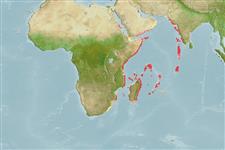>
Holocentriformes (Squirrelfishes, soldierfishes) >
Holocentridae (Squirrelfishes, soldierfishes) > Holocentrinae
Etymology: Sargocentron: Greek, sargos = sargus + Greek, kentron = sting (Ref. 45335).
More on authors: Smith & Smith.
Environment: milieu / climate zone / depth range / distribution range
Ecologia
marinhas associadas(os) a recifes; intervalo de profundidade 2 - 6 m (Ref. 27370). Tropical
Western Indian Ocean: Oman (Ref. 11441), Seychelles, Mauritius, Reunion (Ref. 33390), Comoros (Ref. 27370), Madagascar, Chagos Archipelago, and St. Brandon Shoals.
Tamanho / Peso / Idade
Maturity: Lm ? range ? - ? cm
Max length : 27.0 cm TL macho/indeterminado; (Ref. 9710)
Espinhos dorsais (total): 11; Raios dorsais (total): 12-14; Espinhos anais 4; Raios anais : 8 - 10. Body with about equal stripes of brownish red and silvery white; spinous dorsal mostly white, membrane tips yellow, basal part of fin red except base of first two membranes which are whitish (Ref. 4201). Five oblique scale rows on cheek; body depth 2.4-2.65 in SL; head length (HL) 2.55-2.9 in SL; short and blunt snout, its length 4.15-4.6 in HL; interorbital width 4.5-5.2 in HL; mouth terminal, maxilla usually extending posterior to center of eye, upper jaw length 2.2-2.45 in HL; premaxillary groove nearly or just reaching a vertical at front edge of orbit; anterior end of nasal bone with a blunt spine; surface or medial edge of nasal bone spineless; nasal fossa without spinules; upper edge of 1st suborbital bones with a row of recumbent spinules, the 1st (slightly posterior to a vertical at front edge of orbit) is the largest and most lateral; preopercular spine usually slightly more than 1/2 orbit diameter, 4.0-5.7 in HL; 3rd-5th dorsal spines longest, 1.75-2.15 in HL; 3rd anal spine 1.3-1.55 in HL (Ref. 27370).
Found in shallow waters of coral reefs and rocky shores (Ref. 4201). Often found between branching corals (Ref. 9710).
Ciclo de vida ou comportamento de acasalamento
Maturidade | Reprodução | Desova | Ovos | Fecundidade | Larvas
Randall, J.E., 1998. Revision of the Indo-Pacific squirrelfishes (Beryciformes: Holocentridae: Holocentrinae) of the genus Sargocentron, with descriptions of four new species. Indo-Pac. Fish. (27):105 p. (Ref. 27370)
Status na Lista Vermelha da UICN (Ref. 130435)
Ameaça para os humanos
Harmless
Uso pelos humanos
Mais informação
Nomes comunsSinônimosMetabolismoPredadoresEcotoxicologiaReproduçãoMaturidadeDesovaAgregação de desovaFecundidadeOvosDesenvolvimento dos ovos
ReferênciasAquaculturaPerfil para aquaculturaEstirpesGenéticaElectrophoresesHereditariedadeDoençasProcessamentoNutrientsConversão de massa
ColaboradoresFotosStamps, Coins Misc.SonsCiguateraVelocidadeTipo de nataçãoÁrea branquialOtólitosCérebrosVisão
Ferramentas
Relatórios especiais
Baixar XML
Fontes da internet
Estimates based on models
Preferred temperature (Ref.
123201): 25.4 - 28.9, mean 27.2 °C (based on 435 cells).
Índice de diversidade filogenética (Ref.
82804): PD
50 = 0.5000 [Uniqueness, from 0.5 = low to 2.0 = high].
Bayesian length-weight: a=0.01622 (0.00774 - 0.03400), b=2.97 (2.80 - 3.14), in cm total length, based on LWR estimates for this Genus-body shape (Ref.
93245).
Nível Trófico (Ref.
69278): 3.6 ±0.5 se; based on size and trophs of closest relatives
Resiliência (Ref.
120179): Elevada, tempo mínimo de duplicação da população menor que 15 meses (Preliminary K or Fecundity.).
Fishing Vulnerability (Ref.
59153): Low vulnerability (17 of 100).
Nutrients (Ref.
124155): Calcium = 58.9 [23.4, 216.2] mg/100g; Iron = 0.517 [0.197, 1.555] mg/100g; Protein = 18.7 [17.5, 19.9] %; Omega3 = 0.117 [0.051, 0.276] g/100g; Selenium = 22.2 [12.6, 43.7] μg/100g; VitaminA = 76.3 [27.1, 211.2] μg/100g; Zinc = 1.92 [0.81, 3.78] mg/100g (wet weight);
